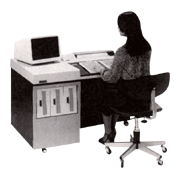This was Japan's first kanji (Chinese character) office computer, marketed by Toshiba in 1978. There were three models (the Model 10, 20 and 30) which were based on the TOSBAC System 15. These models had enhanced kanji capabilities while inheriting the model system of the System 15. There were differences in the kanji handled by these models. The Model 10 could handle JIS C 6226 (hereafter called "JIS Kanji") Level 1 (approx. 3,300 characters); the Model 20 could handle JIS Kanji Level 1 and 2 (approx. 6,600 characters); and the Model 30 could handle 11,000 characters, including JIS Kanji Level 1 and Level 2. From the beginning, the TOSBAC Kanji System 15 supported 24x24dot fonts for both print and display, and with the Model 20 and 30, it was possible to print and display kanji up to Level 2.
Four methods of kanji input were provided: direct input, kana-kanji conversion (one character conversion), idiom input and JIS Japanese character code input (postal code input for entering addresses was added in later functional enhancement). The keyboard of the input unit was not a so-called "full keyboard"; it was a "book mat" type keyboard (called a "touch-in" keyboard in the System 15). The book mat keyboard had two sets of 192 rod shaped keys similar to small posts (perhaps they should be called push-buttons). On the other hand, there was also a component called a "book" in which plastic sheets were bound (14 page book), and this was used by opening it and placing it over the keyboard. The plastic pages comprising the book had 192 holes at the points corresponding to the keyboard keys, and were designed to fit smoothly over the keyboard. The data input by pressing each key was printed below the hole on each page. The book mat was a keyboard originally developed to facilitate entry of codes, such as product codes or customer codes, and multiple books could be used to suit the codes being input. One of the provided books was a kanji master book used for kanji input. When entering kanji, the kanji master book was combined with the book mat keyboard, and different pages were used for each of the four input methods (direct input, kana-kanji conversion input, idiom input and JIS Japanese character code input). The photograph below shows a woman operating the book mat keyboard with the book open and in place.


